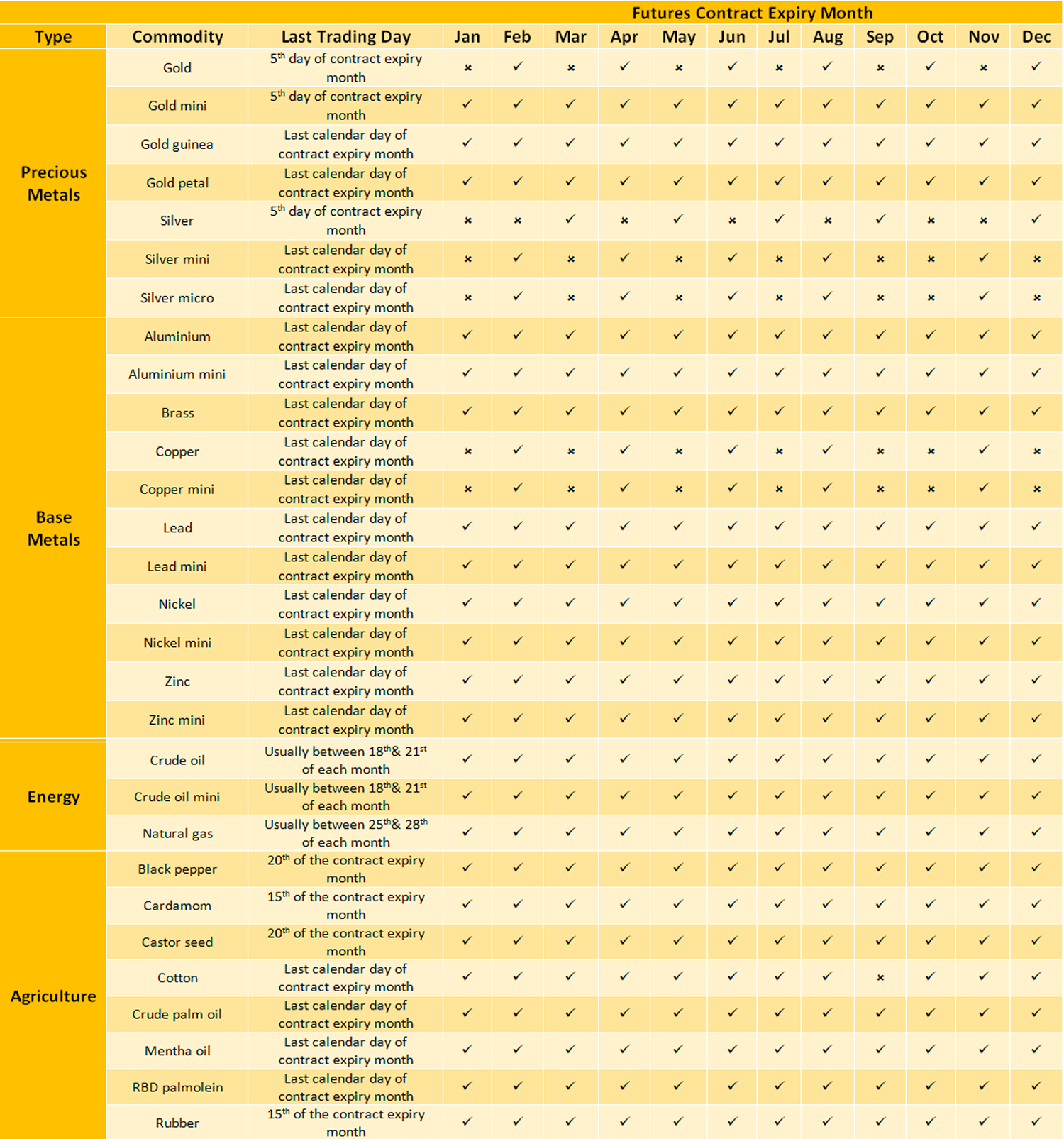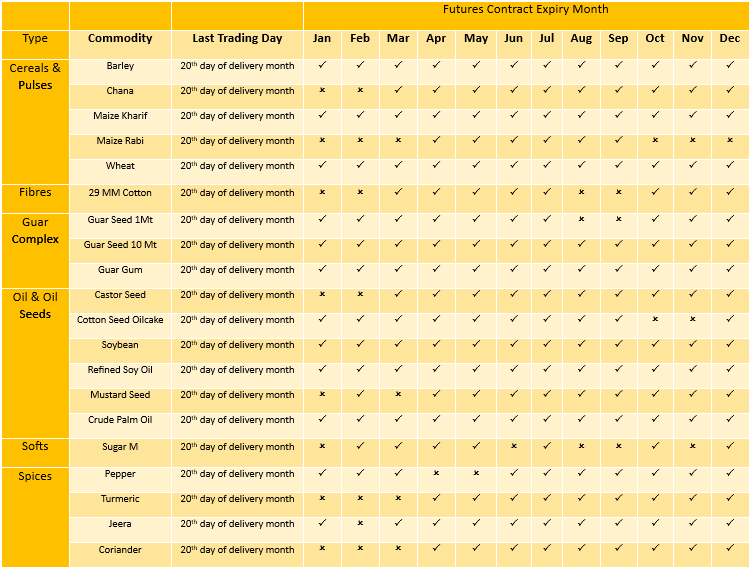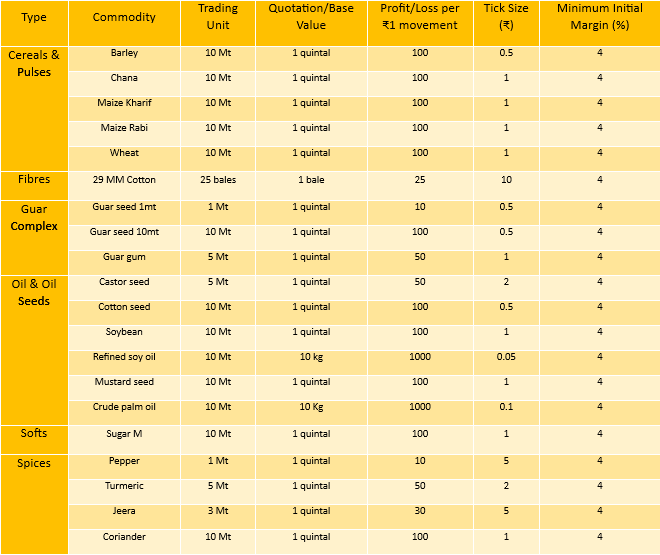
MCX commodity contracts
The table below shows the months for which commodity futures are available for trading on the MCX:
The table below shows the contract specifications for MCX commodities
NCDEX commodity contracts
The table below shows the months for which commodity futures are available for trading on the NCDEX:
The table below shows the contract specifications for NCDEX commodities:
Note: Kindly note that all the details which have been mentioned above pertaining to various specifications of commodity futures contracts on the MCX and the NCDEX are subject to change from time to time as per the policies of the exchanges. For latest and updated information on individual commodity contracts, readers are advised to view the MCX and NCDEX circulars that are periodically displayed on the exchange website.
Terms and Terminologies
In the above two sections, we have talked about various aspects relating to contract specifications. Let us now talk about some minor aspects pertaining to the terms and terminologies mentioned above.
Last Trading Day:This refers to the last day when a derivative contract is traded. After the last trading day, the contract ceases to exist. Traders must close their positions before the last trading day, else they will be forced to give/take delivery (in case of delivery-based contracts) or settle the position in cash (in case of cash-based contracts).
Trading Unit:This refers to the size (in weight) of the commodity position. For instance, the trading unit of gold is 1kg, which means when a trader takes a position in gold it will be 1kg or in multiples thereof. A 1-lot position in gold means a trader has taken exposure to the tune of 1kg, while a 5-lot position in gold means a trader has taken exposure to the tune of 5kgs.
Quotation per Base Value:This refers to the unit in which the price is quoted. For instance, the quotation of gold is price per 10 grams. This means the price that appears on the trading terminal is quoted in terms of 10 grams (such as ₹30,000 per 10gms).
Profit/Loss per ₹1 Movement:This refers to the profit or loss that a trader would make per ₹1 movement in the quoted price of the commodity. For instance, the profit/loss per ₹1 movement for gold is 100, meaning every ₹1 movement will cause a profit/loss of 100. So, if a trader has a long position in gold and the price of gold increases from ₹30,000 to ₹30,020, the trader would profit ₹2,000 (100 * [₹30,020 - ₹30,000]). Conversely, a short position would mean a loss of ₹2,000 in case the price of gold moves up by ₹20.
Tick Size (₹):This refers to the minimum price that a commodity can move in either direction. For instance, the tick size for gold is ₹1, which means any increase or decrease in the price of gold will be ₹1 or in multiples of ₹1. So, if gold is currently trading at, say ₹30,000, the next tick could be any value in multiples of ₹1, such as ₹30,001 or ₹30,020 or ₹29,990 etc. It can’t be something like ₹30,001.50.
Initial Margin:This refers to the minimum margin that a trader needs to have in his margin account before taking a trading position. This figure is expressed as a percent of the total contract value. For most commodities traded on the MCX, the initial margin is currently 4%. So, in case of gold, if the metal is currently trading at ₹30,000, the total contract value per lot is ₹30,00,000 (remember, the trading unit for gold is 1kg). As such, at a rate of 4%, the initial margin turns out to be ₹1,20,000. This is the minimum amount that a trader needs to have in his account to take a position in gold.For carrying positions beyond a day, the initial margin charged is usually higher than 4%. Depending on volatility, margins can vary widely. The general rule is- the higher the volatility, the higher the margin, and vice versa.Compared to equity derivatives, commodity derivatives that are traded on the MCX are more leveraged – sometimes extending to 25x of the total contract value.
Next Chapter
Comments & Discussions in
FYERS Community

.png)


sachidanada murthi commented on June 14th, 2019 at 10:41 PM
Thanks for the detailed explanation, I want to why there is a different expiry date for the commodities.
tejas commented on August 30th, 2019 at 3:46 PM
This is done at the discretion of MCX. It can also be done for the sake of operational efficiency.
Srihari commented on June 14th, 2019 at 11:21 PM
I have a small doubt about the expiry date. What happens to the contract if I don't close my open position till the expiry of the contract.
tejas commented on August 30th, 2019 at 3:48 PM
Our Risk Management team will close the position before the delivery intention date. If we don't close it for whatsoever reason, then you will be obliged to take delivery and pay up the full margin in case you are long. If you are short, then you have to give delivery. To avoid this situation, remember to square off your position before you run into such inconveniences.